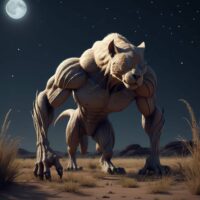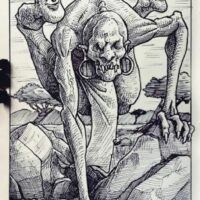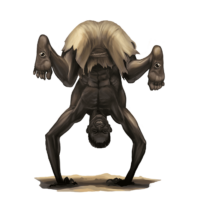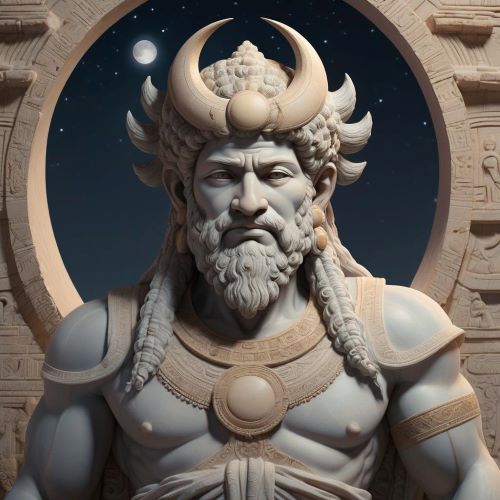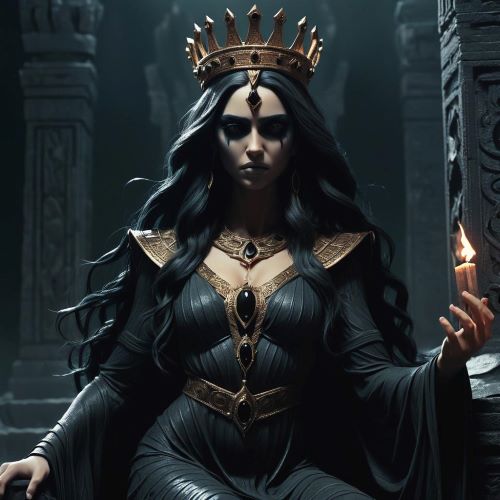Ningal : The Moon Goddess
Listen
Ningal
Introduction
Ningal, whose name in Sumerian means “Great Lady,” was a prominent goddess in ancient Mesopotamian religion and mythology. Revered as the consort of the moon god Nanna (Sin in Akkadian), she played a foundational role in the spiritual life of cities like Ur and Harran. More than a passive divine figure, Ningal embodied the essence of motherhood, sorrow, and cosmic order. Though ancient, her presence has not faded into obscurity. Her myths, hymns, and symbolic associations with lunar rhythms continue to resonate with those interested in divine femininity and celestial lore.
Physical Traits
Depictions of Ningal varied across time and regions, with no single, definitive iconography. However, the symbolism in her portrayals often emphasized intimacy with the moon and graceful serenity. In one of the most notable reliefs, the Ur-Nammu Stele, she appears seated on Nanna’s lap, illustrating their unity and shared authority. Sometimes, a crescent moon—linked to her husband’s astral domain—accompanies her image, reinforcing her lunar connections. Scholars have also debated her association with birds such as geese or swans, animals often seen as nurturing and protective. While the identification remains inconclusive, the recurring avian motif strengthens the perception of Ningal as a divine matron of peace and maternal care. Rather than focusing on martial prowess, her visual narrative evoked a quiet but immense cosmic presence.
Family
The divine genealogy of Ningal highlights her importance in Mesopotamian theology. She was the daughter of Ningikuga, a deity associated with purity and the reeds of the marshlands, and possibly the god Enki, a powerful force of wisdom and water. Ningal’s partnership with Nanna was not just symbolic but foundational to the divine structure, as their union birthed several key deities. Their daughter Inanna, later equated with Ishtar, embodied love, war, and planetary influence, while their son Utu (or Shamash) ruled over justice and the sun. Other deities—such as Ereshkigal, Manzat, and Numushda—are sometimes counted among their children, depending on local traditions. Through these familial bonds, Ningal’s influence extended from the moon to the underworld, to the daily rise of the sun, integrating her into the fabric of both time and terrain.
Other names
Ningal’s worship was not confined to Sumer alone. Her name and attributes migrated across the ancient Near East, evolving in pronunciation and function. In Akkadian, Hurrian, and Ugaritic texts, she appears as Nikkal, maintaining her lunar identity while adapting to regional pantheons. For instance, in Ugarit, she is Nikkal-wa-Ib, consort of the moon god Yarikh, demonstrating her mythic flexibility and her role in uniting celestial couples across cultures. Regional Sumerian titles such as Nin-Gala and Nin-Uruwa further reflect her honorific status and the reverence with which she was invoked in liturgical and cultic contexts. These name variations testify to her widespread influence and adaptability within differing theological frameworks.
Powers and Abilities
Ningal’s powers were subtle but profound. She governed domains traditionally linked to femininity and intuition—fertility, dreams, divine foresight, and ecological balance. Her most poetic attribute lies in dream divination. In Mesopotamian belief, dreams were seen as divine messages, and Ningal was invoked in interpreting them. This spiritual function placed her as a guide to priests, prophets, and ordinary dreamers seeking celestial insight. She also embodied the fertility of both land and body. In early hymns, Ningal demands that the world become bountiful before she unites with Nanna, symbolizing her role in bringing forth abundance. Her symbolism of a water vessel with a fish, echoing the womb, further ties her to creation and renewal.
Her connection to astral bodies is reflected in epithets that speak of light and stars—Si-iminbi (“sevenfold light”) and Ninmulnunna (“lady, star of the prince”)—linking her divine energy to cycles of illumination and cosmic balance. Ningal also appears in incantations against witchcraft and disease, lending her healing authority to early medicine. The term “hand of Ningal” in medical texts possibly referred to a specific ailment, signifying her influence even in early diagnoses and treatments. She may have served as a spiritual protector in this domain, reinforcing the idea of divine intervention in health and wellbeing.
Modern Day Influence
Though the ancient temples of Ningal no longer stand, her legacy continues to manifest in cultural, spiritual, and environmental forms. Elements of her character—especially her link with the moon and dreams—find echoes in modern goddess spirituality. She is invoked as a symbol of lunar wisdom, emotional depth, and maternal resilience in meditative practices and rituals. Her historical connection with reeds and marshlands has inspired contemporary eco-feminist movements. Events like the Wings ‘n Water Festival draw from Ningal’s mythos to celebrate the preservation of wetlands and honor feminine ecological stewardship.
Modern interest in intuitive practices and esoteric wisdom also rekindles Ningal’s legacy. The concept of the “third eye” in spiritual traditions—centered on insight beyond ordinary perception—can be traced back to the dream divination practices she inspired. Her influence has extended into literature and music as well. The oldest recorded song with lyrics and musical notation, found in ancient Ugarit, is a hymn to Nikkal, dedicated to her role in a divine wedding. This extraordinary artifact stands as a monument to her enduring cultural presence, immortalizing her not only as a divine figure but as a muse of art and ritual.
In today’s landscape, Ningal serves as an archetype of divine feminine energy—nurturing, intuitive, and protective. Though her voice may be soft in the modern world, its resonance is powerful, echoing through each moonrise, every healing ritual, and the quiet strength of those who revere the cycles of nature and cosmos. Her myths may have been carved in clay, but their meanings continue to be written in the hearts of those who seek balance, empathy, and light in the darkness.
Related Images
Source
Coleman, J. A. (2007). The Dictionary of Mythology: An A-Z of Themes, Legends, and Heroes. Barnes & Noble, Inc.
Frayne, D. (1997). Ur III Period (2112-2004 BC). https://books.google.com/books?id=s6e5FpL9R2EC
George, A. R. (1992). Babylonian Topographical Texts. https://books.google.com/books?id=j3a6JbS892IC
Konstantopoulos, G. (2023). The Divine/Demonic Seven and the Place of Demons in Mesopotamia. https://books.google.com/books?id=7MvFEAAAQBAJ
Multiple Authors. (n.d.). Nanna | Encyclopedia.com. https://www.encyclopedia.com/environment/encyclopedias-almanacs-transcripts-and-maps/nanna
Multiple Authors. (n.d.). Ningal | ancient goddess – Britannica. https://www.britannica.com/topic/Ningal
Nakata, I. (1995). A Study of Women’s Theophoric Personal Names in Old Babylonian Texts from Mari. https://www.academia.edu/download/32297120/A_Study_of_Women_Theophoric_Personal_Names_in_Old_Babylonian_Texts_from_Mari.pdf
Wiggins, S. A. (1998). What’s in a name? Yarih at Ugarit. Ugarit-Forschungen, 30, 761–780.
Frequently Asked Questions
What is lorem Ipsum?
I am text block. Click edit button to change this text. Lorem ipsum dolor sit amet, consectetur adipiscing elit. Ut elit tellus, luctus nec ullamcorper mattis, pulvinar dapibus leo.
What is lorem Ipsum?
I am text block. Click edit button to change this text. Lorem ipsum dolor sit amet, consectetur adipiscing elit. Ut elit tellus, luctus nec ullamcorper mattis, pulvinar dapibus leo.
What is lorem Ipsum?
I am text block. Click edit button to change this text. Lorem ipsum dolor sit amet, consectetur adipiscing elit. Ut elit tellus, luctus nec ullamcorper mattis, pulvinar dapibus leo.
What is lorem Ipsum?
I am text block. Click edit button to change this text. Lorem ipsum dolor sit amet, consectetur adipiscing elit. Ut elit tellus, luctus nec ullamcorper mattis, pulvinar dapibus leo.
What is lorem Ipsum?
I am text block. Click edit button to change this text. Lorem ipsum dolor sit amet, consectetur adipiscing elit. Ut elit tellus, luctus nec ullamcorper mattis, pulvinar dapibus leo.


